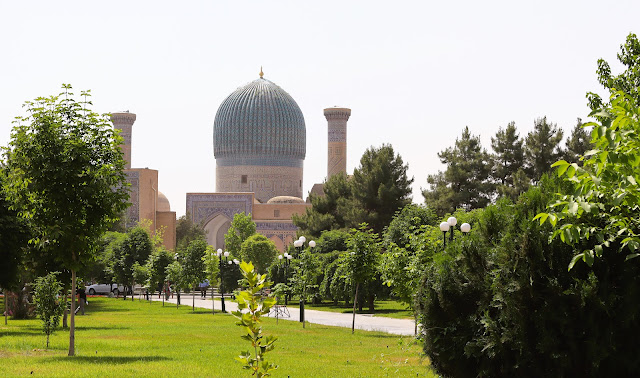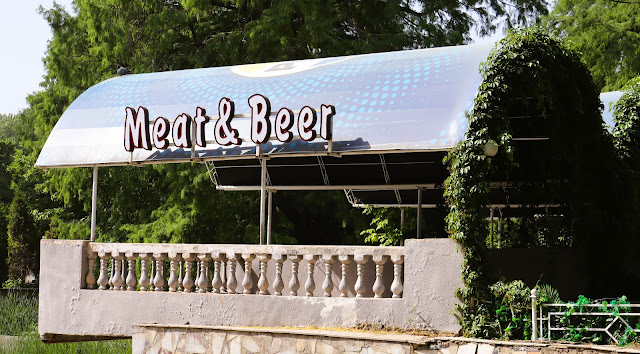Again, we arrive late from the train, getting to the hotel (Mixt Royal Palace) at about 8 pm. The woman at the desk gives us the name of the Samarkand restaurant in the area, and off we go.
First, we pass by a raucous room where our ears are assaulted with loud music. Young and old dance, sing, laugh and talk. There are balloons and gifts. Obviously, some kind of party or parties are going on.
Then we are led through an outdoor area.
Finally, we get to the large indoor space, a visual circus that can't be easily summed up. At first, it appears disparate, but it all comes together nicely.
In the photo below, on the left is one of many ceramic poles serving as light standards and next to it is a close-up of the intricate work. On the far right, a very clever idea for a light source over a table. Someone has drilled holes in the bottom of ceramic bowls that are wide enough to pass an electric cable through, and on the lowest bowls is a lightbulb.

Many bookcases like this are on the walls, full of eclectic pieces.
Many traditionally carved and painted ceiling pieces are hung at various heights.
This wall mural high up on the wall is three dimensional.
There's at least one occupied bird in a cage on each wall, and huge vases hang from the ceiling.
Children are running around everywhere. Youth have gathered at tables, as have tourists and adult locals. There is a sense of chaos, but the waiters control it all like a perfected dance.
Good food, good prices and a unique atmosphere, so we return for subsequent meals.
The morning of the first day dawns early, so we can participate in a Guru Walk. We realize that our hotel is within walking distance of all the major monuments, restaurants, markets, wine and beer store, Central Park, the University and a Hammam, should we decide to partake in a public bathhouse.
The Guru walk meeting place is at the entrance to Gur-e Amir (Tomb of the King). This imposing statue of Amir Timur (AKA Tamerlane) leads us to the mausoleum.
Guru leader Fayoziddin shares this photo of the group. We are from India, America, Britain and Canada.

Before going any further, we have to mention the big man at the back of the group. He is an American (retired), now in his third year of a solo around-the-world trip on a motorcycle. We are in awe of his accomplishments to date.
On this four-hour tour, we are also scheduled to enter the Khazrat Khizir Mosque and the Chorsu Art Gallery (no entry fee). From the outside, we are to see three monuments: Registan Square, Bibi Khanum Mosque and Shakhi Zinda, which all have entrance fees, so we learn about them and can return on our own the next day to explore at our leisure. Also, we view the Siab Bazaar from the outside and can return on our own.
The mausoleum of Amir Temur (entrance fee for both of us, CAD 5.40)

The entrance is stunning, as fits the leader of a nation. The layers of mosaic inside the arch are especially fascinating.
Inside is breathtaking, with gold glittering everywhere, subtly highlighted with swatches of blue.
The second main coffin is that of Amir Timur. He explicitly ordered that he be laid at the feet of his spiritual mentor Mir Said Baraka, who is in the first main coffin. Surrounding Timur are the coffins of his two sons and two grandsons.
The grounds around this mausoleum are expansive, with many trees and flower beds. By ten o'clock in the morning, workers are covering up the flowers to protect them from the excessive heat.
On another day, wandering the grounds, we discover the Ruhobad Complex, a mausoleum built for a spiritual leader during Timur's reign.
Surrounding this complex is a madrassa now turned into an arts and crafts learning and economic center. We discovered two new-to-us types of craftsmen.
One is a metal carver, using a small chisel and a tap hammer to create an engraved design within each of the raised fan shapes that you see below. He is working from the bottom (where you can see some completed engraving) up. Meticulous work!
The other trade new to us was craftsmen who created beautiful purple boxes of various sizes used for presenting gifts. They looked like blue velvet on the outside and were lined with soft Styrofoam, followed by white fabric on the inside, with brass hardware.
In the photo below, you can see some square frames for the boxes and other materials used. The finished boxes are in blue.
Between the Mausoleum and the Registan was an interesting wall mural and the Chorsu Art Gallery.The Chorsu Gallery was in a dome, painted white on the inside, with good lighting. This exquisitely hand-painted chair is beautiful.
THE REGISTAN
The name means sandy place or desert.
In medieval times, the Registan served as a public gathering space for everything from royal proclamations to public executions. It was surrounded by markets and caravans. It has survived everything from natural disasters to invasions by Genghis Khan.
Today, it still feels like the heart of Samarkand. If we could only see one thing in Uzbekistan, it would be this. The Registan is a UNESCO World Heritage Site with the theme, Samarkand, a Crossroads of Cultures.

From afar, the Registan is clearly expansive. But until you are inside the gates and gazing up at the buildings, you cannot realize the immensity of it all.
It has three buildings: The Ulugh Beg Madrassa, built from 1417 to 1420; the Sher Dor Madrassa from 1619 to 1636; and the Tilya-Kori Madrassa from 1646 to 1660.
Today, none of these run as schools. They are simply a magnificent tourist attraction. As usual, the work of artisans are on display and for sale.

SIYOB MARKET
Covering seven hectares, this is the largest market in Samarkand, visited by locals and tourists. Its name comes from the Siyob River that flows near it.
It has seven large covered pavilions with counters and several more with shops.
This is the first time that we have seen the flat bread with colours on it.
HAZRAT KHIZR MOSQUE
This mosque, built in the 8th century, sits high atop the Afrasiab hill and is named after a leader in the Islamic faith.
It has a domed interior.
The carved and painted ceiling is called an avian ceiling.
These lovely young women were pleased to have their photo taken.
The mausoleum that is part of this complex holds the remains of Uzbekistan's first president, Islam Karimov.
BIBI KHANYM MOSQUE
Amir Timur wanted the biggest mosque in the world built to house the remains of his wife, so he imported craftsmen. He issued commands about the dimensions of the building, but nothing this grand had ever been attempted before.
Our guide tells us a story that the head of construction reported his doubts about being able to achieve Timur's vision and was given a choice: build it or learn to fly (from a minaret).
The building was completed while Timur was away for five years. Soon after his return, the building started to collapse and break apart. It was abandoned and never finished. We never heard if the man responsible learned to fly.
It's worth going to the internet to read about some of the mysteries and legends that surround this necropolis, the burial place of royals and nobles. Its name means 'the living thing'.
This complex was built over 8 centuries (from the 11th to the 15th centuries and again in the 19th century) and has 20 buildings. Its beautiful blue domes are stunning in the sunlight, as are the tile exteriors. Many are finished inside with tilework as well.




Sometime, somewhere in Samarkand, we were in this golden mosque. I wish I could remember where, as it was so stunning.
And somewhere off to the side was a room with some artifacts. All were behind glass, so the glare doesn't work for photos. I had to take one of these very unusually shaped clay vessels.
It is impossible to not notice the expansive parks and green spaces in Samarkand, so on our last day, we relax and wander through just a few of the twenty or so significant parks.
A little research tells us about the history and development of the parks:
- The gardens from the 14th and 15th centuries (Islamic times), such as the one at the Registan, have water fountains, channels and geometric layouts. Islamic cultural tradition values gardens as a metaphor for paradise.
- The Russians introduced two kinds of parks, one with a European influence, with more landscaping styles, promenades and ornamental plantings; and others with large recreational spaces, cultural venues and monuments.
- Finally, the modern parks combine traditional parks with modern amenities.
Note the golden crown that's the centerpiece of this fountain
On the University grounds!This, a block from our hotel, is Alisher Navoi, the great poet and intellectual and his best friend. It often seems like one vast park leads into another, so our walking about takes more hours than expected.
The name of this park remains a mystery, but it obviously has a Chinese influence. It includes a water feature and two lovely arched wood walkways.
And to end the walk, we stumbled on a beautiful Russian Orthodox Church, St Alexius.
MISCELLANEOUS PHOTOS
S
amarkand has three graveyards, one each for Muslims, Christians and Jewish people. There is an old Jewish Quarter, but we didn't get there.Too late, we read about a part of Samarkand that we didn't get to, Konigil Village, a place in nature where traditional crafts are practised, especially making paper by hand.
You can read about it here. Modern paper has a lifespan of forty years, while the handmade paper from here lasts four hundred years!
With some regret, we prepare to leave Samarkand and its wonderful people.
We feel richer for having been to Uzbekistan. It makes us think about the other 'Stans which we didn't visit.
Thank you Uzbek
I take a final glance at the kitschy ceramic figurines that were available in all the tourist spots. They are made to express the sunny disposition of the Uzbek people, and on reflection, they serve their purpose.
The airport is seen from a long distance as the highway takes you there. It is a reminder of how well Samarkand is combining old with new.
This photo is from a visit Uzbekistan page on the web.










































































What a feast for the eyes, my friends. Thanks for that and the great story that keeps unfolding!
ReplyDeleteSo nice to hear from you again Annie. Many beautiful things to see in Uzbekistan
ReplyDeleteAnother amazing update on your adventure. Thank you for work you do. Looking forward to hearing about your trek in Romania. Jo-Ann
ReplyDeleteHi JoAnne. Thanks for your encouraging words. Sometimes it feels like too much to travel and write, but as a team we get it done
ReplyDelete